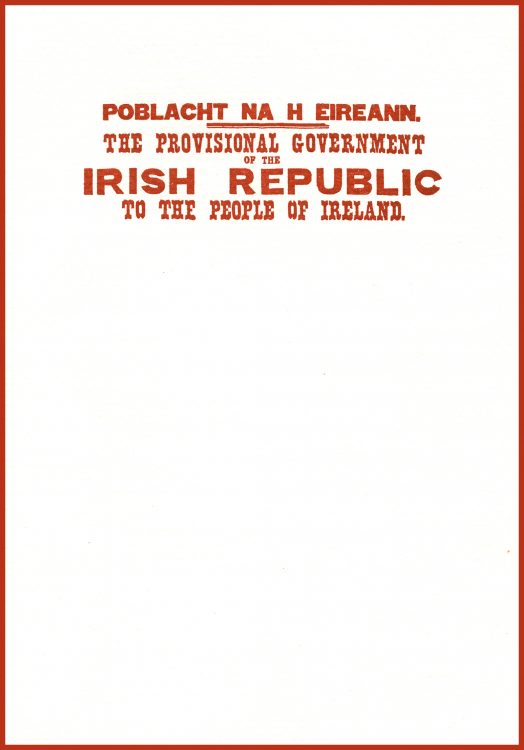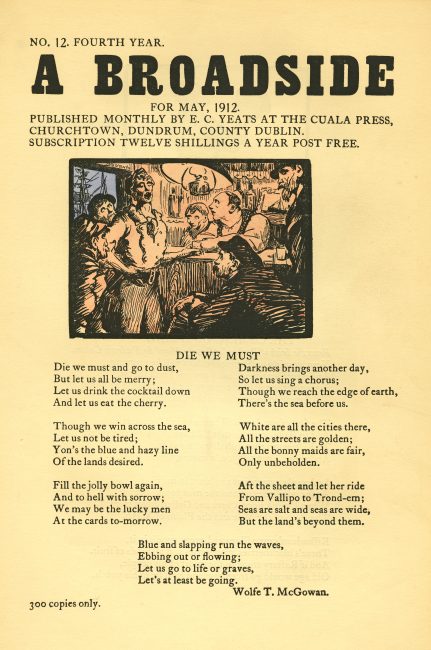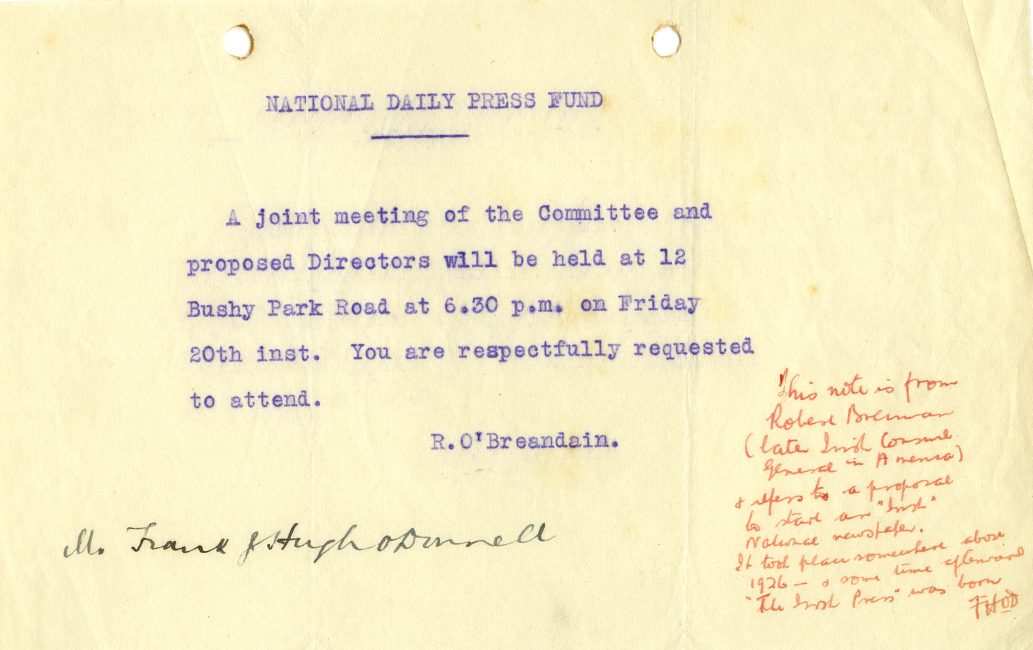Clarke, Thomas, Seán MacDiarmada, Pádraig Pearse, James Connolly, Thomas MacDonagh, Eamonn Ceannt, Joseph Mary Plunkett. Poblacht na hEireann: the Provisional Government of the Irish Republic to the people of Ireland. Bethesda, Maryland: Wild Apple Press, 2005.
The press played an important part in contributing to the rise of nationalism in Ireland, beginning in the mid-nineteenth century. Advertising ("Buy Irish") was a subtle form of encouraging nationalism through economics. Advertisements for Irish goods typically also featured shamrocks, Celtic knots, and Irish-styled typefaces.
On Friday, April 21, the Poblacht na hEireann was printed at Liberty Hall on the Double Crown Wharfdale James Connolly had used for the Workers’ Republic. Connolly also had acquired a supply of type from printer Joseph Stanley. The compositors Michael J. Molloy and Liam O Briain, members of the Irish Citizen Army, knew there would not be enough type at Liberty Hall. A friendly English printer set up in Capel Street, William Henry West, provided the rebels with several cases of type.
After Pearse read the Proclamation in front of the General Post Office, James Connolly tasked Seán T. O’Kelly (who became President of Ireland in 1945) with distributing copies throughout Dublin. It was O’Kelly who kept several copies for posterity.
The British army found the press on which the Proclamation had been printed still intact when soldiers entered Liberty Hall on Wednesday, April 26. The Proclamation actually been printed in two halves due to its size, and the British soldiers found only the second plate. Some printed copies from this plate as souvenirs.
What happened to the manuscript the printers worked from is a mystery. It is generally believed that it was left in Liberty Hall after the printing was completed. Liberty Hall was ravaged by gunfire and shelling and suffered major fire damage during Easter Week.
Edited by W.B. Yeats and his sisters Susan (also known as Lily) and Elizabeth Yeats, A Broadside was a Cuala publication (June 1908-May 1915) that published new and traditional poems in the ballad style accompanied by illustrations by Jack B. Yeats (usually handcolored).
“Wolfe T[one] McGowan” was one of Jack Yeats’s pseudonyms.
Brennan, Robert. National Daily Press Fund meeting invitation, circa 1926. Frank J. Hugh O’Donnell papers
Robert Brennan (1881-1964) helped organize militia volunteers in Wexford and was quartermaster of the local Brigade. He and his wife Una Brenna (1888-1958) were both involved in the Rising in Wexford. The first female member of the Irish Republican Brotherhood, Una Brennan was one of the three women volunteers who raised the tricolor over the Athaneum in Enniscorthy. Robert Brennan was sentenced to death, but the sentence was commuted. He was imprisoned briefly in Dartmoor Prison. Following his release, Brennan continued his political activity, which resulted in a second imprisonment in Cork City Gaol in 1917.
By 1918, Brennan was active with Sinn Féin and was Director of Elections in the 1918 General Election. Brennan was arrested and imprisoned once more in 1920, but his political career continued to flourish. Following service as Irish Under-Secretary for Foreign Affairs, he became director of publicity for the Republican Forces during the Irish Civil War.
Brennan helped found The Irish Press and served as general manager from 1930 until 1934, when he was appointed Secretary to the Irish Legation in Washington. In 1938, Brennan was appointed Charge d'Affaires and in August of that year became Irish Minister in Washington. In 1947 Brennan returned to Ireland to assume the position of Director of Broadcasting at Radio Eireann. Brennan retired from that position in 1948. Following his retirement Brennan wrote extensively and produced fiction, including novels, short stories, and mysteries, plays, and essays.
The invitation is written under the Gaelic version of Brennan’s name. O’Donnell annotated the invitation:
This note is from Robert Brennan (later Irish Consul General in America) & refers to a prospect to start an “Irish” national newspaper. It took place somewhere about 1926—&some time afterward “The Irish Press” was born.
-FHOD
Tuam (Co. Galway) is known as one of Ireland’s oldest religious centers, with ruins dating to the sixth century C.E. It was also likely Ireland’s capital during the twelfth century. The Tuam Match Factory, situated along the Curragh River, was in operation during the latter half of the nineteenth century, and a series of its colorful matchbook covers featured scenes of hurling and Gaelic football teams. Advertised as “The Gaelic Match” and adorned with shamrocks, the matchbook covers appeal to Irish consumers encouraged to buy Irish goods.





